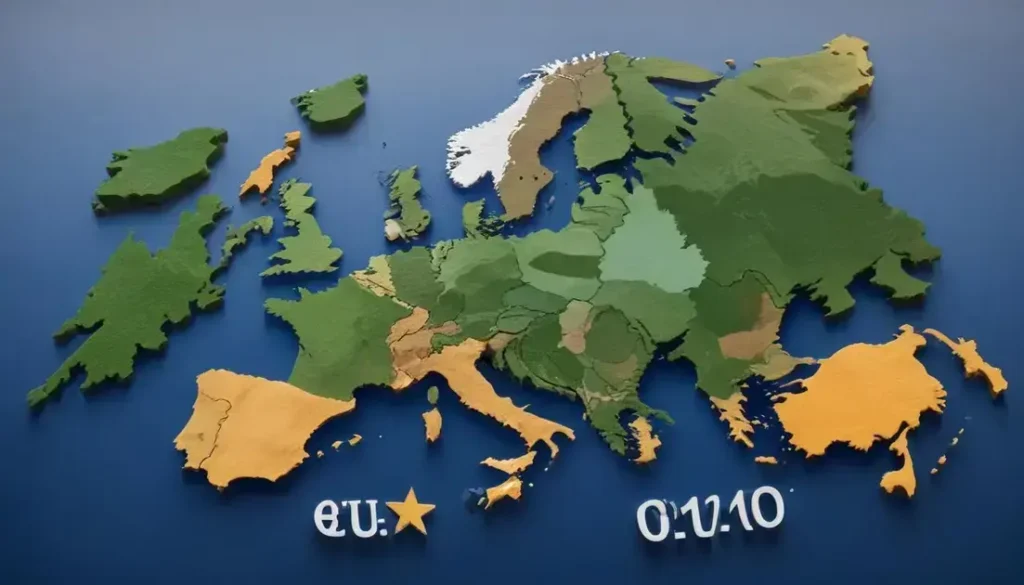Blue finance focuses on innovative financial strategies that support the sustainable use and conservation of ocean resources, crucial for combating environmental challenges while promoting economic growth in coastal communities.
In today’s climate crisis, blue finance emerges as a crucial tool for investors and businesses aiming to protect our oceans while ensuring economic growth. What does this mean for the future?
Understanding Blue Finance
Understanding Blue Finance is essential for grasping how financial mechanisms can support the health of our oceans. This innovative approach integrates economic activities with the preservation and restoration of marine ecosystems. By channeling funds toward sustainable marine projects, blue finance helps tackle pressing environmental challenges.
One vital aspect of blue finance is the emphasis on sustainable investment. Investors are encouraged to put their money into initiatives that not only promise a financial return but also contribute positively to ocean health. This includes investing in marine protected areas, sustainable fisheries, and renewable energy from ocean resources.
Furthermore, blue finance fosters collaboration among various stakeholders, including governments, non-profit organizations, and the private sector. By working together, these entities can leverage resources and expertise to maximize the impact of their efforts. This collective approach is crucial for ensuring the long-term sustainability of marine ecosystems.
In summary, blue finance represents a transformative opportunity to align financial interests with environmental stewardship. By understanding and implementing its principles, we can pave the way for a healthier ocean and a more sustainable future for all.
Importance of Ocean Conservation
The importance of ocean conservation cannot be overstated, as oceans play a vital role in sustaining life on Earth. They regulate climate, provide food, and support a diverse range of species. Protecting these ecosystems is essential for maintaining biodiversity and ensuring the health of our planet.
Oceans cover more than 70% of the Earth’s surface, and they are a source of livelihood for millions of people worldwide. Healthy oceans contribute to livelihoods in fishing, tourism, and recreation. However, increasing threats such as pollution, overfishing, and climate change jeopardize these benefits.
Conservation efforts focus on restoring marine habitats, reducing plastic waste, and implementing sustainable fishing practices. By prioritizing ocean health, we can help combat climate change and promote resilience among marine ecosystems.
Moreover, engaging communities and fostering awareness about the significance of sustainable ocean management is crucial. Collaboration among stakeholders, including governments, non-profits, and businesses, can lead to more effective conservation strategies. Together, we can forge a path toward a future where both people and oceans thrive.
Standard Chartered’s Initiatives
Standard Chartered’s initiatives in ocean conservation demonstrate a strong commitment to sustainability and responsible finance. The bank aims to integrate environmental considerations into its core business strategies. By promoting blue finance, Standard Chartered invests in projects that protect marine ecosystems while generating economic growth.
One significant initiative is the funding of sustainable fishing practices that help mitigate overfishing and preserve fish populations. This supports coastal communities and enhances food security. Additionally, the bank collaborates with various stakeholders, including environmental organizations, to develop innovative solutions that address ocean-related environmental issues.
Standard Chartered also emphasizes the importance of raising awareness about ocean health. Through community engagement and educational programs, the bank encourages individuals and businesses to adopt sustainable practices that contribute to marine conservation. This holistic approach strengthens their role as a leader in responsible banking.
Furthermore, the establishment of partnerships with governmental and non-governmental organizations enhances the effectiveness of these initiatives. By leveraging resources and expertise, Standard Chartered is making a significant impact on ocean health and sustainability, paving the way for future generations to thrive.
Impact on Coastal Communities
The impact on coastal communities from initiatives like those of Standard Chartered is profound. These communities often rely on healthy oceans for their livelihoods, including fishing and tourism. By promoting sustainable practices, Standard Chartered helps ensure that these communities can continue to thrive economically.
One notable effect is the enhancement of food security through sustainable fishing practices. By supporting efforts to reduce overfishing, these initiatives help maintain fish populations, which are essential for local diets and economies. This stability leads to increased resilience in coastal areas, preventing economic downturns associated with depleted marine resources.
Furthermore, community engagement initiatives raise awareness of the importance of ocean health. Programs that educate local populations about sustainable practices empower them to take action in preserving their marine environment. This collaboration fosters a sense of ownership, ensuring that local voices are heard in conservation efforts.
Moreover, investments in marine infrastructure can improve the quality of life in these communities. Developing eco-friendly tourism attracts visitors and generates income without harming ecosystems. The dual focus on economic development and environmental sustainability allows coastal communities to flourish in harmony with nature.
Partnerships for Sustainable Growth
Partnerships for sustainable growth are essential for advancing ocean conservation and creating lasting impacts. Collaborative efforts among governments, businesses, and non-profit organizations enhance resource sharing, driving innovation in sustainable practices. These alliances facilitate the pooling of expertise that enables efficient responses to environmental challenges.
One key area of focus for these partnerships is sustainable fishing. By working together, stakeholders can establish best practices that ensure fish populations remain healthy while supporting local economies. This collaborative approach also helps balance economic needs with environmental responsibilities.
Moreover, partnerships often lead to innovative financial mechanisms, such as blue bonds, which dedicate capital to ocean conservation efforts. These financial tools attract investors while promoting projects that restore marine ecosystems, ultimately benefiting coastal communities.
Education and community engagement are also crucial components of successful partnerships. Through joint initiatives, organizations can raise awareness about the importance of ocean health and encourage local populations to actively participate in conservation efforts. This community involvement fosters a sense of ownership and accountability for preserving marine environments.
Overall, strategic partnerships facilitate the transition toward a more sustainable future. By uniting diverse stakeholders, these collaborations pave the way for impactful solutions that protect our oceans and enhance economic growth.
Financial Strategies in Ocean Health
Financial strategies in ocean health play a crucial role in promoting sustainable practices for preserving marine ecosystems. These strategies aim to align financial incentives with environmental outcomes, addressing the urgent need for conservation in the face of climate change and overfishing.
One effective approach is the use of impact investing, where investors fund projects that yield both financial returns and positive environmental impacts. This includes investments in sustainable fisheries, aquaculture, and marine habitat restoration projects that directly contribute to ocean health.
Additionally, the introduction of blue carbon credits has emerged as an innovative financial mechanism. These credits allow businesses to offset their carbon emissions by investing in coastal ecosystems like mangroves and seagrasses, which absorb carbon dioxide. This not only helps combat climate change but also enhances biodiversity and ecosystem services.
Furthermore, creating partnerships between governments, NGOs, and the private sector can facilitate the development of financing tools that support marine conservation. Such collaborations can lead to the establishment of sustainable finance frameworks that prioritize environmental health while promoting economic growth.
By implementing these financial strategies, we can foster a more sustainable relationship with our oceans, ensuring their health for future generations while supporting local economies and communities.
Supporting the UN’s Sustainable Development Goals
Supporting the UN’s Sustainable Development Goals (SDGs) is vital for ensuring a sustainable future for our oceans and planet. Specifically, Goal 14, which focuses on conserving and sustainably using the oceans, seas, and marine resources, requires collective action from multiple stakeholders.
Many organizations and governments are aligning their efforts with the SDGs to address pressing issues like overfishing, marine pollution, and habitat destruction. By implementing strategies that promote sustainable fishing and reducing plastic waste, they contribute to a healthier marine environment.
Furthermore, collaboration is essential for achieving these goals. Partnerships between public and private sectors can enhance funding for sustainable ocean projects. For example, governments can create policies that incentivize sustainable practices among businesses, which can lead to positive outcomes for both the economy and the environment.
Moreover, public awareness campaigns support the SDGs by educating communities about the importance of ocean health. Engaging local populations in conservation initiatives allows them to take an active role in protecting marine ecosystems.
By fostering global cooperation and commitment to the SDGs, we can ensure the long-term sustainability of our oceans. This holistic approach not only benefits marine life but also strengthens the resilience of communities that rely on ocean resources.
Future of Marine Conservation Financing
The future of marine conservation financing is vital in the ongoing effort to protect our oceans and marine resources. As the impacts of climate change and human activities increase, innovative financial solutions are necessary to ensure sustainable practices in marine environments.
One promising strategy involves the rise of blue finance, which focuses on funding initiatives that promote the sustainable use of ocean resources. This includes investments in renewable marine energy sources and ocean-based ecosystem restoration projects. These investments not only foster environmental benefits but also create economic opportunities for local communities.
Additionally, the use of green bonds has gained traction in supporting marine projects. These financial instruments are specifically earmarked for environmental projects, allowing investors to directly contribute to ocean health while receiving returns on their investments. This model can mobilize significant capital towards marine conservation efforts.
Moreover, partnerships between governments, non-profits, and the private sector will play a crucial role in driving innovation in marine financing. Collaborative efforts can lead to the development of frameworks that prioritize environmental resilience while promoting economic growth.
Ultimately, the future of marine conservation financing relies on a multi-faceted approach that integrates financial tools with community engagement, stakeholder collaboration, and a commitment to long-term sustainability.
In conclusion, the future of ocean conservation is promising
With the right financial strategies and collaborative efforts, we can create a more sustainable relationship with our oceans. By embracing blue finance and innovative funding tools like green bonds, we can invest in marine health while also supporting local economies.
Partnerships between governments, businesses, and communities are essential for effective conservation. Through shared goals and resources, we can tackle environmental challenges and promote responsible use of ocean resources.
As we look ahead, it is crucial to remain committed to these initiatives, ensuring the protection of our marine ecosystems for future generations. Together, we can foster a healthier ocean and a more sustainable planet.
Frequently Asked Questions (FAQ)
What is blue finance and why is it important?
Blue finance refers to financial mechanisms that support the sustainable use and conservation of ocean resources. It is important because it helps tackle environmental challenges while promoting economic growth for coastal communities.
How do partnerships contribute to marine conservation?
Partnerships among governments, businesses, and NGOs enhance resource sharing and collaboration, leading to innovative solutions for marine conservation and sustainable practices.
What are green bonds and how do they support ocean health?
Green bonds are financial instruments specifically designed to fund projects that have positive environmental impacts, including ocean conservation initiatives, helping attract investment for sustainable marine practices.
How can communities engage in marine conservation efforts?
Communities can engage by participating in education programs, supporting sustainable practices, and taking part in local conservation initiatives that protect marine ecosystems.
What role does public awareness play in ocean conservation?
Public awareness is crucial for promoting sustainable practices and encouraging individuals to take action in protecting ocean health, leading to broader community involvement in conservation.
How can individuals invest in marine conservation?
Individuals can invest in marine conservation through impact investing, supporting companies with sustainable practices or contributing to funds that focus on ocean health and restoration projects.


